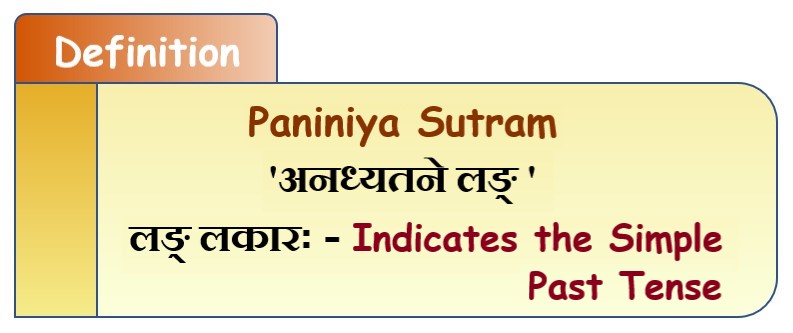 | We learn about........ | |
| We have so far learned in this module... |
|
| The goal of this lesson is to learn ….. |
|
संभाषण-वर्गः Video chosenfor this lesson turns out to be a revision on द्वितीया-विभक्ति-प्रयोगः. We also revisit the use of ‘तः’ (तसिल्) endings to प्रातिपदिकानि.
| Conversation Practice - सम्भाषणाभ्यासः | ||
|---|---|---|
| किं पठामि / जानामि ? | ||
| अहं ग्रन्थं पठामि । | अहं विज्ञानं जानामि । | |
| भवान् / भवन्तः / भवती / भवत्यः कं कां पृच्छतु? / पृच्छन्तु? | ||
| अहं नकुलं पृच्छामि । | अहं स्वातिं पृच्छामि । अहं रञ्जितां पृच्छामि । | |
| रामः | अनन्तम् | पृच्छति । |
| रमेशं | ||
| भारतीं | ||
| लतां | ||
| गीतां | ||
| सुरेशं | ||
| मालतीं | ||
| अमरं | ||
| गृहतः, विदेशतः, विद्यालयतः, आपणतः, वित्तकोषतः, मार्गतः, कार्यालयतः, हिमालयतः, वृक्षतः, वाटिकातः, सञ्चिकातः, स्थालिकातः, नदीतः, लेखनीतः, कूपितः, मन्दिरतः, पुष्पतः | ||
| कुतः किं स्वीकरोति | ||
| अहं | पेटिकातः उपनेत्रं | स्वीकरोमि |
| कूपीतः जलं | ||
| सञ्चिकातः पत्रं | ||
| शारदातः लेखनीं | ||
| यतीन्द्रतः करवस्त्रं | ||
| कोषतः लेखनीं | ||
| कुतः किं आनयन्ति ? | ||
| अहं | वित्तकोषतः धनम् | आनयामि |
| नदीतः जलम् | ||
| अरण्यतः फलम् | ||
| आपणतः / शालातः पुस्तकम् | ||
| विद्यालयतः सुधाखण्डम् | ||
| वाटिकातः पुष्पम् | ||
| कुतः कुत्र गच्छति ? | ||
| अहं | आपणतः मन्दिरं | गच्छामि |
| हिमालयतः स्वर्गं | ||
| किमर्थम् ? | ||
| अहं | ज्ञानार्थं | पठामि |
| पिपासा निवारणार्थं जलं | पिबामि | |
| अहं | आनन्दार्थं | नृत्यं करोमि |
| ध्यानं करोमि | ||
| शान्त्यर्थं | गीतं गायामि | |
| रामायणं पठामि | ||
| अपि | ||
| यतीन्द्रः उत्तिष्ठति, आदित्यः अपि उत्तिष्ठति । | श्रीनिका लिखति, शारदा अपि लिखति । | |
| सः नाटकं पश्यति, चलचित्रं अपि पश्यति । | ||
| अस्तु ! धनं ददातु । | विद्यां ददातु । तथास्तु ! | |
In Samskrit past tense verb forms are formed by combining the ‘लङ् लकारः’ with roots (धातवः).

Let us look at the pictorial explanations given below on Past tense forms of अस्ति (अस्-धातुः) etc..
| प्रथमपुरुषः | |||
|---|---|---|---|
 | अधुना पुष्पम् अस्ति । | पूर्वं कलिका आसीत् । |  |
 | अधुना पुष्पे स्तः । | पूर्वं कलिके आस्ताम् । |  |
 | अधुना पुष्पाणि सन्ति। | पूर्वं कलिकाः आसन् । |  |
| मध्यमपुरुषः | |||
 | त्वं अधुना जननी असि । | पूर्वं त्वं बालिका आसीः । |  |
 | युवां अधुना जनन्यौ स्थः । | पूर्वं युवां वालिके आस्तम् । |  |
 | यूयं अधुना जनन्यः स्थ । | पूर्वं यूयं बालिकाः आस्त । |  |
| उत्तमपुरुषः | |||
 | अहम् अधुना अध्यापकः अस्मि । | पूर्वं अहं छात्रः आसम् । |  |
 | आवाम् अधुना अध्यापकौ स्वः । | पूर्वं आवां छात्रौ आस्व । |  |
 | वयम् अधुना अध्यापकाः स्मः । | पूर्वं वयं छात्राः आस्म । |  |
The above table clearly shows the ‘लङ्’ forms of ‘अस् धातुः’ against the corresponding ‘लट्’ forms. These forms correspond to English verb forms ‘was or were’. Let us now tabulate the conjugated लङ् forms of अस् धातुः against their पुरुष and वचनम्.
| लङि ‘अस्’ धातोः परस्मैपदरूपाणि – Past tense forms of ‘अस्’ | |||
|---|---|---|---|
| एकवचनम् | द्विवचनम् | बहुवचनम् | |
| प्रथमपुरुषः | आसीत् | आस्ताम् | आसन् |
| मध्यमपुरुषः | आसीः | आस्तम् | आस्त |
| उत्तमपुरुषः | आसम् | आस्व | आस्म |
Let us recollect the Samskrit Names for Today, Yesterday and day before Yesterday which we learned in the lesson “Tell time in Samskrit”. We revisit them using suitable Kriya Rupani.
| अद्य Today | दशदिनाङ्गः | अस्ति |
| रविवासरः | ||
| ह्यः Yesterday | नवदिनाङ्गः | आसीत् |
| शनिवासरः | ||
| परह्यः Day before Yesterday | अष्टदिनाङ्गः | |
| शुक्रवासरः | ||
| प्रपरह्यः Two days before Yesterday | सप्तदिनाङ्गः | |
| गुरुवासरः |
अस्-धातुः assumes special forms in all lakaras. भू-धातुः has the same meaning as अस्-धातुः (to be) and also assumes standard verb forms. In this lesson we can learn the लङ् forms of भू-धातुः and also form few example sentences. We will be learning the general conjugational process in the next lesson.
| लङि ‘भू’ धातोः परस्मैपदरूपाणि – Past tense forms of ‘भू’ | |||
|---|---|---|---|
| एकवचनम् | द्विवचनम् | बहुवचनम् | |
| प्रथमपुरुषः | अभवत् | अभवताम् | अभवन् |
| मध्यमपुरुषः | अभवः | अभवतम् | अभवत |
| उत्तमपुरुषः | अभवम् | अभवाव | अभवाम |
Here are some example sentences using the past tense forms of भू-धातुः
| प्रथमपुरुषः | ||
|---|---|---|
| एकवचनम् | द्विवचनम् | बहुवचनम् |
| वृक्षः पूर्वम् अङ्कुरः अभवत् । The tree was earlier a sapling. | तरुणौ पूर्वं बालकौ अभवताम् । (Two) Young men were earlier boys. | भवन्तः कार्यालये अभवन् । You (many) were in the Office. |
| मध्यमपुरुषः | ||
| त्वं कुत्र अभवः ? Where were you? | ह्यः युवां गृहे अभनतम् वा ? Were you two in the house yesterday? | यूयं छात्राः अभवत । You (many) were students. |
| उत्तमपुरुषः | ||
| अहं तत्र न अभवम् । I was not there. | आवां विद्यालये अभवाव । We two were at the School | वयं बालकाः अभवाम । We were boys. |
किञ्चित् अभ्यासं कृत्वा समापयामः । Let us complete the lesson by doing some practice exercises.
सः, तरुणः, वृद्धः
अधुना सः वृद्धः अस्ति / भवति ।
पूर्वं सः तरुणः आसीत् / अभवत् ।
We welcome your views and suggestions on this lesson. Please post your comments and replies after registering. Please also send a mail to samskrit@samskritaveethy.com for any clarification on the lesson.
We have so far learned....
We introduced the past forms (लङ्) of ‘अस्’ and ‘भू’ in this lesson. The forms of ‘भू’ follows the general pattern of लङ् forms. We learn about the general rule and deal with other verb roots in our next lesson.
Lesson 14: Samskrit Past Tense Forms Part - II- भूतकाले लङ् २
 | 0 comments |
To get updates on
संस्कृतवीथी...